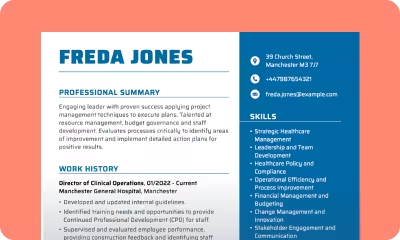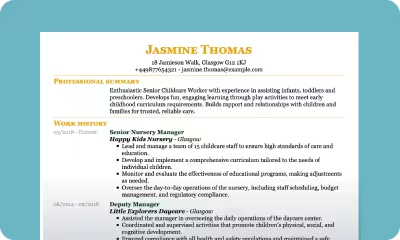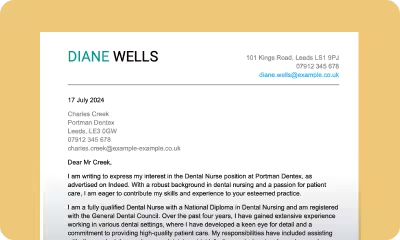- Our customers have been hired by : *Foot Note
In England, enrolling in higher education often carries a hefty price tag. With tuition fees reaching up to £9,250 per year and living costs continuing to rise, many students find themselves in need of financial assistance. The loans offered by Student Finance England have become an essential lifeline for countless students, allowing them to access quality education regardless of their financial situation.
However, securing this vital financial support can be a daunting endeavour. Many students find themselves overwhelmed by the somewhat complex application process, which requires detailed personal information, proof of financial circumstances, and of course a student finance cover letter.
It’s not easy crafting a compelling case demonstrating our eligibility and genuine necessity for financial assistance when the stakes are this high. We get it. That is precisely why we created the following guide, which will take you through the whole process of creating a successful student finance cover letter.
To give yourself a head start, be sure to also check out our cover letter examples. Following their lead, you’ll be able to write a cover letter you can truly have faith in when it comes to getting you the outcome you need.
Student Finance Cover Letter Sample
Craft a compelling student finance cover letter with the help of our cover letter templates. Get to grips with cover letter writing, structure and formatting, and waste no more time worrying about your future.
Take a look at the student finance cover letter examples we’ve compiled for you below.
Anna McDonald
195 Crown Street
London W12 4WB
07912 345 678
anna.mcdonald@example.co.uk
30 August 2024
Student Finance England
100 Companies House
Crown Way
Cardiff, CF14 3UZ
Customer Reference Number: 12345678901
Dear Sir/Madam
I am writing to apply for student finance for the upcoming academic year 2024-2025. As a second-year student at University College London, studying Computer Science, I am requesting financial support to cover my tuition fees and living costs.
The purpose of this letter is to provide you with the necessary information to
process my application and to highlight a few key points about my circumstances. Firstly, I come from a low-income household and require full financial support to continue my studies. Additionally, I have recently been diagnosed with dyslexia, which necessitates additional support for my studies, including specialised software and extra tutoring. Lastly, due to the ongoing cost of living crisis, I am finding it increasingly difficult to manage my living expenses alongside my academic commitments.
I have enclosed all the required supporting documents with this application. These include my proof of identity (passport), university acceptance letter, medical evidence of my dyslexia diagnosis, and household income information. I hope these documents will provide a comprehensive overview of my situation and support my application for student finance.
If you require any additional information or documentation to process my application, please don’t hesitate to contact me. Thank you for considering my application. I look forward to hearing from you soon.
Yours faithfully,
Anna McDonald
How to Write a Cover Letter for Student Finance
You likely spent some time procrastinating on starting your cover letter. The task probably fills you with dread and it feels like your whole future is on the line.
The pressure of crafting a compelling narrative that effectively communicates your financial needs and personal circumstances can understandably feel overwhelming. However, your student finance cover letter isn’t torture by design. It’s there as your personal introduction to Student Finance England, providing context to your application and helping the organisation understand your unique circumstances.
With that in mind, mastering the art of cover letters is essential. Your cover letter for student finance can mean the difference between a smooth application process and one fraught with misunderstandings or delays. In the following sections, we’ll break down the process step by step, helping you get to grips with cover letter writing and ace your student finance application

Here’s your student finance cover letter step by step:
Step 1: Do Some Prep
While you might be giddy to start writing your student finance cover letter right away, do hold your horses. Research is a crucial first step in creating an effective cover letter for Student Finance England. After all, you must have a firm idea of the requirements and the eligibility criteria used by the organisation in assessing your loan application before you put your pen to paper.
Start by visiting the official Student Finance England website and carefully reading through the relevant sections. See if you can find any specific instructions regarding cover letters, required information, or preferred formats. Familiarising yourself with these details will enable you to tailor your student finance cover letter to fully meet their expectations.
Step 2: Include Contact Information and Date
The next crucial step in creating your student finance cover letter is formatting the header correctly. This section is extremely important, as it includes contact information and sets a professional tone for your letter.
Start your cover letter by listing your full name, address, phone number, and email address at the top of the page. Under these details, add the current date. Then, after a space, include the recipient’s information: “Student Finance England” followed by their full address.
Remember to include your Customer Reference Number (CRN) prominently, either under the header or at the very top of the document. This number is key for linking your cover letter to your application.
In the end, you should have something that looks like the following:
Samantha James
4 Bold Street
Liverpool L1 4JG
07912 345 678
samantha.james@example.com
30.08.2024
Student Finance England
100 Companies House
Crown Way
Cardiff, CF14 3UZ
Customer Reference Number: 12345678901
Step 3: Address Your Reader
As you start your cover letter, it’s important to strike the right tone of respect and formality in your salutation. When addressing Student Finance England, the most appropriate greeting is “Dear Sir/Madam”. While this type of salutation is generally advised against in job application cover letters, maintaining a formal tone is recommended when writing to Student Finance England.
Make sure to steer clear of overly casual greetings such as “Hello”, as this can come across as unprofessional in this context. Another frequently used salutation that should be avoided is “To Whom It May Concern”, which is seen as outdated and too impersonal.
While this is generally uncommon for Student Finance England applications, if it so happens that you know the name of the specific individual reviewing your application, you can use “Dear Mr/Ms” followed by their surname as a salutation.
Dear Sir/Madam
OR
Dear Mr McDonald
Step 4: Craft an Effective Opening Paragraph
Whether you’re writing your student finance cover letter or school essay, the quality of your opening paragraph can determine whether you’re successful or otherwise. That’s because it sets the tone for your entire letter and serves as that famous first impression that’s also notoriously hard to recover from, when less than positive.
Start your cover letter by clearly stating the reason for your letter, then briefly mention your current academic status, your year of study, university name, and chosen course of study. If you haven’t added it to your header, then cite your Customer Reference Number (CRN) in your opener, so the person reading your letter can quickly retrieve your application.
Any details beyond those mentioned above are best saved for the later paragraphs. You want to keep your student finance cover letter concise, clear and to the point. Keeping to 2-3 sentences in length is generally the sweet spot for this section.
I am writing to apply for student finance for the upcoming academic year 2023-2024 (Customer Reference Number: 12345678901). As a second-year Biochemistry student at the University of Manchester, I am seeking support for my tuition fees and living costs. I’m also requesting additional consideration due to a recent change in my family’s financial circumstances.
OR
I am writing in regard to my application for student finance for the 2023-2024 academic year (CRN: 98765432101). As an incoming first-year student accepted to study Computer Science at Imperial College London, I am applying for full tuition fee support and maintenance loan. Additionally, I would like to highlight my status as a care leaver, which may affect my eligibility for additional financial assistance.
Step 5: Demonstrate Your Eligibility
The body of your application to Student Finance England should clearly explain your financial situation and any factors preventing you from funding your studies, such as family income, dependants or special circumstances. Be honest and transparent about your needs and include any sources of income, such as part-time work or benefits.
Specify the type of financial support you’re applying for, whether it’s a tuition fee loan, maintenance loan or grant, and provide a breakdown of your education and living costs.
If applicable, mention any recent changes in your family situation, such as job loss or illness, that affect your finances.
Finally, briefly outline your academic goals and how the funding will help you achieve them, and explain how you plan to manage your finances responsibly during your studies.
The purpose of this letter is to provide you with the necessary information to process my application and to highlight a few key points about my circumstances. Firstly, I come from a low-income household and require full financial support to continue my studies. Additionally, I have recently been diagnosed with dyslexia, which necessitates additional support for my studies, including specialised software and extra tutoring. Lastly, due to the ongoing cost of living crisis, I am finding it increasingly difficult to manage my living expenses alongside my academic commitments.
OR
My current financial situation presents significant challenges in funding my education. I have savings of £2,000 from my part-time job, where I earn £500 per month working 20 hours a week. However, this falls considerably short of covering my tuition fees and living expenses.
The total cost of my education, including tuition fees (£9,250) and estimated living expenses (£8,000), amounts to approximately £17,250 per year. This includes accommodation (£5,000), course materials (£500), and daily living costs (£2,500). The gap between my available resources and total costs is around £14,750 annually.
Step 6: Reference Supporting Documents
A crucial part of your evidence cover letter for student finance is referencing the supporting documents you’re submitting as part of your application.
Remember to be specific about the documents you’re including and double-check your list before sending your application and cover letter. After listing your documents, it’s a good idea to offer assistance if any questions arise.
This section serves as a bridge to your closing paragraph, showcasing your attention to detail, organisational skills, and readiness to be fully transparent about your current situation.
I have attached all necessary documents to support my application, including bank statements, payslips, and evidence of my Jobseeker’s Allowance claim. Please let me know if you require any additional information.
Step 7: End with an Effective Closing Paragraph
Your closing paragraph is your final opportunity to leave a lasting impression on the Student Finance employee reviewing your application. The aim of this paragraph is also to effectively wrap up your letter while reinforcing your key points and maintaining a professional tone.
Start by briefly summarising the main reasons why you require financial assistance. A concise, to-the-point recap of your most compelling arguments will help solidify your case in the reader’s mind. Of course, be careful not to simply list all of the applicable reasons, but rather synthesise them into a strong final statement.
Don’t forget to thank the reader for their time and consideration, and convey your enthusiasm about the prospect of pursuing your studies. It’s also important to indicate your willingness to be contacted should any additional information be required. Doing all of the above shows you’re professional, committed and thorough, qualities which are highly valued in the application process.
Finally, end with a polite call to action, stating that you look forward to hearing from them regarding your application.
I am deeply grateful for your consideration of my application for student finance. The opportunity to study Economics at the London School of Economics would be transformative for my academic and professional future. Your financial support would allow me to fully immerse myself in my studies and take advantage of all the learning opportunities available. I am committed to making the most of this chance and contributing positively to the academic community. If you require any further information to support my application, please don’t hesitate to contact me. I look forward to your response and the possibility of pursuing my educational goals with your assistance.
OR
I appreciate your time in reviewing my application. Studying Environmental Science at Manchester is my passion, and your financial assistance would be crucial in achieving this goal. I’m prepared to manage any support responsibly. If you require any additional details, please let me know. I’m eager to hear your decision.
Step 8: Sign Off Appropriately
After ending your closing paragraph on a strong note, it’s just as important to end your student finance cover letter with an appropriate sign-off. This final touch adds to the professional feel of your entire letter, helping maintain a positive impression right through to the very end.
For a formal letter to Student Finance England, more traditional, respectful sign-offs are recommended. Use “Yours sincerely” if you’ve addressed your letter to a specific person, or “Yours faithfully” if you’ve used a general greeting.
Yours sincerely,
Samantha James
OR
Yours faithfully,
Samantha James
Step 8: Review and Polish
Before submitting your cover letter for Student Finance, it’s vital that you spend some time reviewing and polishing your work. It’s no secret that errors are pretty much guaranteed when writing our first draft, which is precisely why this final step is so important. So, go ahead and step away from your student finance cover letter for a while, so you can return with fresh eyes, more likely to spot whatever needs fixing.
Make sure to check for formatting inconsistencies throughout your letter. This includes font size, spacing, and margins. Double-check whether all the documents you’ve referenced in your letter are actually included in your application, so you can spare yourself the stress of any delays to your application.
Supplement Your Student Finance Income
It’s a universally acknowledged fact that most students live from one payment cycle to the next. Improve your cash flow with a professionally written university student CV, proven to help you land your desired part-time jobs while at university. Check out our cover letter and CV builders to quickly craft a job application that ticks all the boxes.
Frequently Asked Questions About a Student Finance Cover Letter
Should I mention my academic achievements in the cover letter?
While the main focus of a student finance cover letter should be on your financial circumstances and need for support, briefly mentioning your academic achievements or goals can also be valuable. After all, it shows you’re a dedicated individual, committed to continuing your studies despite your financial hardships.
That said, make sure to keep it concise and dedicate no more than a sentence or two to this aspect. Try to highlight only those achievements that are particularly relevant to your chosen course of study.
What is a “student finance cover letter” (or “evidence cover letter”)?Enter your question here
In the UK, especially with Student Finance England and related bodies, a “student finance cover letter” is often what’s called an evidence cover letter: a brief document you submit alongside supporting documents to explain particular circumstances, request additional funding, or clarify special conditions.
This letter helps the reviewer connect your evidence (income proofs, family changes, health issues) to your application
What are common types of evidence / supporting documents
When you submit a cover letter to Student Finance (or equivalent body in Scotland, Wales, Northern Ireland), the evidence you may need often includes:
- Evidence of special conditions or appeals (e.g. caring responsibilities, bereavement)
Can I use the same student finance cover letter for different years of study?
Using the same student finance cover letter for different years of study is generally not advised. It’s very likely that your circumstances, both financial and academic, will look different from year to year, making your original cover letter inaccurate and irrelevant.
Student Finance England has made clear that any changes to your circumstances should be reflected in your letter, so your application can be assessed accordingly. Using the same cover letter for student finance can harm your chances of getting the kind of funding you actually need.
How long should a Student Finance cover letter be?
When it comes to the length of a cover letter for student finance, 300 to 500 words should be sufficient to convey your financial situation. This is more than enough space to make your case effectively without overwhelming the reader with unnecessary, potentially irrelevant details.
Related Cover Letter Examples UK
- Student Cover Letter Examples
- Library Assistant Cover Letter Examples
- Internal Position Cover Letter Examples
- Business Analyst Cover Letter Examples
- Personal Assistant Cover Letter Examples
- Office Administrator Cover Letter Examples
- Customer Service Advisor Cover Letter Examples
- Customer Assistant Cover Letter Examples
- Part-Time Job Cover Letter Examples
- Data Analyst Cover Letter Examples
Set Yourself Up for Success
Embark on your dream academic journey with a student finance cover letter that takes care of all the formalities for you. Our cover letter examples, templates and expert advice are here to help you put your best foot forward and achieve your educational goals.
*The names and logos of the companies referred to above are all trademarks of their respective holders. Unless specifically stated otherwise, such references are not intended to imply any affiliation or association with myperfectCV.



